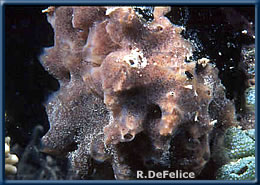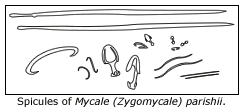

Haliclona caerulea

Gelliodes fibrosa

Suberites zeteki

Zygomycale parishii

Mycale armata
Mycale (Zygomycale) parishii
 Red-brown
branching sponge
Red-brown
branching sponge
Phylum Porifera
Class Demospongiae
Order Poecilosclerida
Family Mycalidae
Description
Growth Form
Thin encrusting to large arborescent, cylindrical digitate branches, few
bifurcations, attached to substrate with basal holdfast.
Color
Color red-brown (most common), brownish purple, or dirty yellow (encrusting
form).
Texture and Surface Features
Soft, spongy, elastic. Surface smooth to uneven with with tangential spicule
skeleton.
 Spicules
Spicules
Megascleres: subtylostyles (320 mm)
Microscleres: sigmas (2 sizes, 25 and 80 mm), toxas, raphides, palmate
anisochelae (2 sizes, 20 and 45 mm), and palmate isochelae (10 mm).
Habitat
In the Hawaiian Islands, this sponge is mainly restricted to shallow-water
fouling communities (i.e. pier pilings, floating docks) of the major harbors
on Oahu or associated disturbed habitats (i.e. dredged channels and artificial
lagoons). In Kaneohe Bay, is found on patch reefs in southeast corner
of the bay as well as the fouling community on Coconut Island floating
docks.
Distribution
Hawaiian Islands
Oahu - Pearl Harbor, Honolulu Harbor, Keehi Lagoon, Barber's Point, and
Kaneohe Bay.
Maui - Kahului Harbor.
Native Range
Caribbean
Present Distribution
Caribbean, Brazil, eastern Pacific at Panama, main Hawaiian Islands, Indo-Malay
Region, Australia, Indian Ocean.
Mechanism of Introduction
Unintentional introduction, most likely as fouling on ships' hull.
Impact
Fouling organism. Ecological impact unstudied, but observations suggests
competition for space with native species.
Ecology
Reproduction
Like all sponges, M. parishii is capable
of asexual reproduction by fragmentation of the adult. Details regarding
sexual reproduction of this species are unknown. (See Reproduction
of Sigmadocia caerulea for general description
of sponge reproduction.)
Feeding
Sponges are filter feeders, continuously circulating water through their
bodies. Microscopic food particles are removed from water by specialized
collar cells. Digestion is intracellular.
Remarks
De Laubenfels (1950) recorded this species first from Kaneohe Bay in 1947,
and further noted that it was abundant on the hulls of vessels that remained
for a year or more in Pearl Harbor. He considered it to be a native species
providing a biogeographical link to East Indian fauna. At the time, M.
parishii was previously known from the Indian Ocean, Indonesia,
and Australia. It has since been reported in New Caledonia, Jamaica and
Brazil (Hechtel 1965). Bergquist (1967) again recorded it from the floating
docks on Coconut Island, Oahu and considered it to be introduced.
This species is considered to be an unintentionally introduced species
to Hawaii due to its widespread distribution and affinity for the fouling
community and associated disturbed habitats.
References
Bergquist, P. R. 1967. Additions to the sponge fauna of the Hawaiian Islands.
Micronesica. 3: 159-174.
de Laubenfels, M. W. 1950. The sponges of Kaneohe Bay, Oahu. Pac. Sci.
4(1): 3-36.
Hechtel, G.J. 1965. A systematic study of the Demospongiae of Port Royal,
Jamaica. Peabody Mus. Nat. Hist. Yale. Bull. 20.
© 2002 Hawaii Biological Survey, Bishop Museum
contact